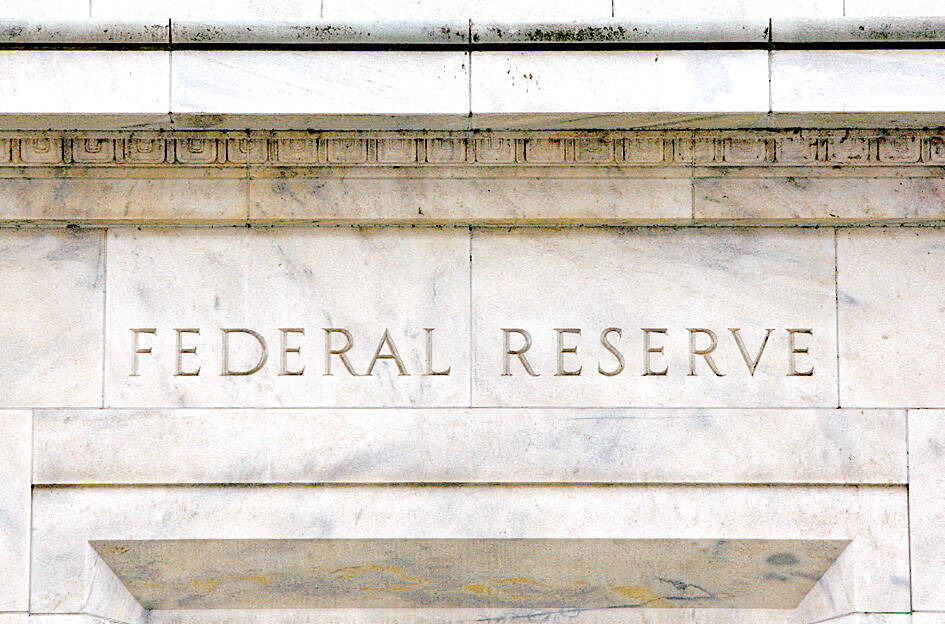Investors were hoping to hear central banks finally signal last week that they were close to finishing raising interest rates in their battle against inflation.
Instead, policymakers indicated that high rates are here for a while yet, with more hikes on the cards and few if any cuts in the near future.
The US Federal Reserve set the tone on Wednesday when it paused its rate-hike campaign, but caused a stir by leaving the door open to another increase before the end of the year.

Photo: Reuters
France’s central bank also unsettled investors by saying that only two cuts were expected next year instead of four as anticipated.
The Fed has more room to keep its “hawkish” stance as the US economy has performed better than feared despite the rate increases.
This firm position is shared by other central banks.
Norway’s rate hike on Thursday was anticipated, but it also said that further tightening was “likely” in December, while ruling out any easing before next year.
This firm tone came “as a surprise to the markets,” which have “decided that the peak” of rate hikes is “happening right now,” even though “central banks’ communications leave the door open to the possibility [of] further hikes,” HSBC Holdings PLC economist Fabio Balboni said.
It leaves “real uncertainty about the level of inflation next year,” he said.
Their decision “reflects a compromise between growth and inflation,” he added.
The rate hikes raise the cost of credit for businesses and consumers, which theoretically in turn reduces demand and inflationary pressures, but if demand slows too much, it runs the risk of triggering a recession.
Faced with this dilemma, the European Central Bank (ECB) on Sept. 14 chose inflation-limiting measures, with a 10th consecutive rate hike. That took its benchmark rate to 4 percent, the highest since 1999.
“We can’t say we have peaked,” ECB President Christine Lagarde said, although other officials indicated that the rate-raising cycle might be coming to a close.
“Our future decisions will ensure that the key ECB interest rates will be set at sufficiently restrictive levels for as long as necessary,” the bank’s chief economist Philip Lane said on Thursday in New York.
However, there are other signs that rates are reaching their peak. The Bank of England on Thursday announced its first pause on raising rates since December 2021, following a slight decline in UK inflation last month.
Switzerland and Japan — like half of all central banks — have also chosen to halt raising rates in the past 10 days.
“We expect no more rate hikes in the future” for the US, UK and European central banks, Balboni said.
Capital Economics Ltd economist Jennifer McKeown said the last hikes would come in the fourth quarter, and that the easing cycle would take hold as next year approaches.
“By this time next year, we anticipate that 21 out of the world’s 30 major central banks will be cutting interest rates,” she wrote in a note.
Although Balboni, taking a more measured stance, said “in the context of weak growth, it will be very complicated to reduce rates” while inflation remains “too high.”
Instead, he believes reductions to US rates would not be seen until the third quarter of next year, while the rest of the world would have to wait until 2025 for rate relief.

The US dollar was trading at NT$29.7 at 10am today on the Taipei Foreign Exchange, as the New Taiwan dollar gained NT$1.364 from the previous close last week. The NT dollar continued to rise today, after surging 3.07 percent on Friday. After opening at NT$30.91, the NT dollar gained more than NT$1 in just 15 minutes, briefly passing the NT$30 mark. Before the US Department of the Treasury's semi-annual currency report came out, expectations that the NT dollar would keep rising were already building. The NT dollar on Friday closed at NT$31.064, up by NT$0.953 — a 3.07 percent single-day gain. Today,

‘SHORT TERM’: The local currency would likely remain strong in the near term, driven by anticipated US trade pressure, capital inflows and expectations of a US Fed rate cut The US dollar is expected to fall below NT$30 in the near term, as traders anticipate increased pressure from Washington for Taiwan to allow the New Taiwan dollar to appreciate, Cathay United Bank (國泰世華銀行) chief economist Lin Chi-chao (林啟超) said. Following a sharp drop in the greenback against the NT dollar on Friday, Lin told the Central News Agency that the local currency is likely to remain strong in the short term, driven in part by market psychology surrounding anticipated US policy pressure. On Friday, the US dollar fell NT$0.953, or 3.07 percent, closing at NT$31.064 — its lowest level since Jan.

The New Taiwan dollar and Taiwanese stocks surged on signs that trade tensions between the world’s top two economies might start easing and as US tech earnings boosted the outlook of the nation’s semiconductor exports. The NT dollar strengthened as much as 3.8 percent versus the US dollar to 30.815, the biggest intraday gain since January 2011, closing at NT$31.064. The benchmark TAIEX jumped 2.73 percent to outperform the region’s equity gauges. Outlook for global trade improved after China said it is assessing possible trade talks with the US, providing a boost for the nation’s currency and shares. As the NT dollar

The Financial Supervisory Commission (FSC) yesterday met with some of the nation’s largest insurance companies as a skyrocketing New Taiwan dollar piles pressure on their hundreds of billions of dollars in US bond investments. The commission has asked some life insurance firms, among the biggest Asian holders of US debt, to discuss how the rapidly strengthening NT dollar has impacted their operations, people familiar with the matter said. The meeting took place as the NT dollar jumped as much as 5 percent yesterday, its biggest intraday gain in more than three decades. The local currency surged as exporters rushed to